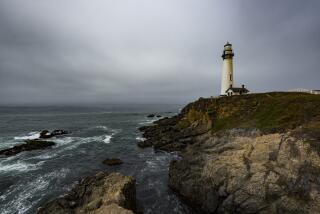Is Glacier National Park past its peak?
Reporting from Glacier National Park, Mont. — Glacier National Park just marked 100 years as crown jewel of the parks system, but questions dot its spectacular landscape as its next century begins.
Will the park’s 2 million tourists still come when the glaciers are gone? Is the nation willing to spend $200 million to repair the cliff-hugging Going-to-the-Sun Road? Will climate change destroy the habitat of grizzly bears, bighorn sheep and other iconic animals?
The first question is perhaps easiest to answer.
“Beauty is beauty,” said Jamie Yuke of Missoula, Mont., one of about 750 people who attended Glacier’s 100th anniversary celebration on Monday. “The majestic scenery will always lure visitors, she said.
The 25 or so remaining glaciers in the park are mostly in the backcountry, and many tourists never see them. What they do see are the jagged, snowcapped peaks that were carved by those glaciers, along with blue lakes, alpine meadows and hiking trails.
But there are those who worry that tourism may drop once the glaciers disappear in the next decade or so.
A recent report by the Rocky Mountain Climate Organization and the Natural Resources Defense Council said climate change threatens the nearly $1-billion-a- year tourism business in Glacier, the 11th most visited national park.
Nearly three-quarters of its visitors are from out of state, and 56% are returnees, the report said.
“I have been coming to Glacier ever since my parents came here on their honeymoon,” Steve Doherty, senior adviser to Interior Secretary Ken Salazar, joked during the anniversary celebration.
Glacier supports more than 4,000 Montana jobs, the report said.
“All the available research tells us that visitors come to Montana primarily for its spectacular unspoiled natural beauty,” Rhonda Fitzgerald, owner of the Garden Wall Inn in Whitefish, said in the report.
The park will inevitably be changed as average temperatures in Glacier have climbed 2 degrees compared with what they were in 1979, double the national average.
“A loss of wildlife in Glacier could result from human-caused climate change,” the report said.
Glacier is the best place in the Lower 48 states to see the full range of mammal predators present at the time of European settlement of America, including bears, wolves, lynx, wolverines and mountain lions, along with mammals such as mountain goats, bighorn sheep and elk.
Glacier has five different life zones, at elevations from 3,000 to 10,000 feet, which support different species of animals and plants. Rising temperatures are pushing the tree line higher up the epic peaks, altering the terrain that animals use for food and cover.
“You can start reshaping animal communities with fairly small changes,” said Dan Fagre, a U.S. Geological Survey scientist. “It’s hard to make clear predictions, other than there will be change.”
A warmer climate is also expected to reduce snowfall. Another recent study projected that before the end of this century, peak snowpack levels in the park may be reached 41 days earlier than in mid-20th century, and that snow could cover the ground for about 70 fewer days a winter.
Forests will become drier as summer progresses, leading to bigger wildfires, said Jack Potter, chief of science at the park.
Less moisture also means lower stream flows, which endanger fish species, he said.
While the climate may be beyond the immediate control of humans, Glacier’s budget is not, and the park faces a huge backlog of repairs, said Glacier spokeswoman Amy Vanderbilt.
The ongoing rebuilding of the Going-to-the-Sun Road alone is budgeted at some $200 million, but future funding is uncertain. The landmark road bisects the park from east to west by snaking through the towering mountains.
The road, which is closed all winter and into the spring each year because of snowfall, is worth about $1 million to the local economy each day it is open, past studies have shown.
The number of visitors to Glacier Park remains steady at about 2 million a year, nearly all of them jammed into the summer months. That’s up from about 4,000 visitors in 1911. The park first topped 1 million annual visitors in 1969, and 2 million in 1983.
But it is still easy to escape the crowds, Vanderbilt said.
“You can easily feel like you are alone in a million-acre wilderness,” Vanderbilt said.
One group that has longer experience in Glacier is the American Indian tribes that have lived here for thousands of years.
Steve Lozar, a tribal councilman for the Confederated Salish and Kootenai Tribes, said Indians will continue to work with non-Indians to protect the region.
“Glacier National Park is 100 years old today,” Lozar said at the ceremony. “We have been on this ground for 14,000 years.
“Together we have honored this holy and sacred ground.”
Geranios writes for the Associated Press
More to Read
Sign up for The Wild
We’ll help you find the best places to hike, bike and run, as well as the perfect silent spots for meditation and yoga.
You may occasionally receive promotional content from the Los Angeles Times.






